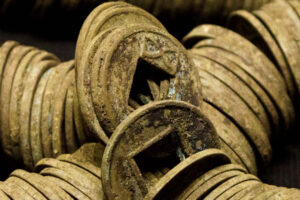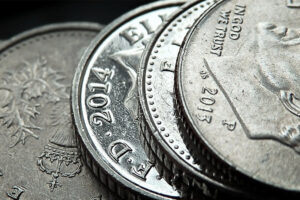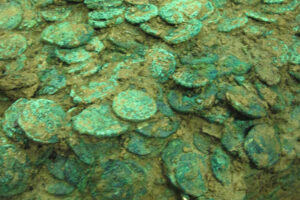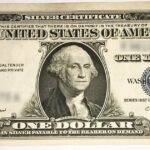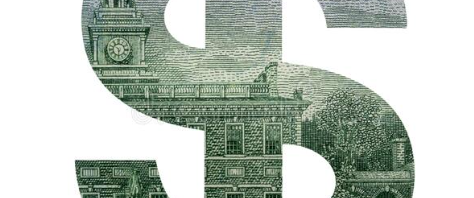The 1957 Silver Dollar Certificate can be worth as much as $250 USD. This piece of American History can be found in varying conditions and these conditions each have their own prospective values.
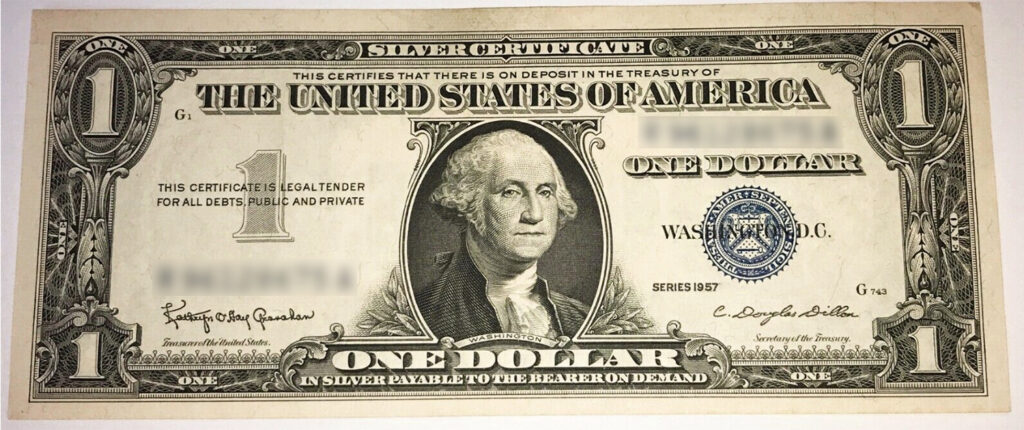
| Condition | Value |
|---|---|
| Uncirculated (UNC, 60-70) | $250 |
| Extremely Fine (EF, 50-58) | $125 |
| Very Fine (VF, 35-50) | $85 |
| Fine (F, 20-35) | $45 |
| Very Good (VG, 12-20) | $26 |
| Good (G, 6-12) | $8 |
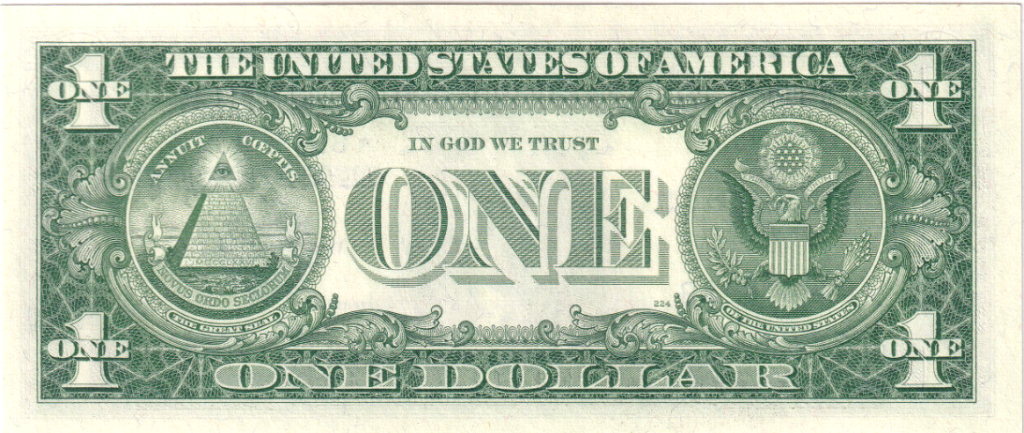
The 1957 Silver Certificate is a type of paper currency issued by the United States government in 1957. These certificates are similar in design and denomination to other types of paper currency from the same era, but are notable for their distinctive blue seal (see image below) and serial numbers, which indicate that they were backed by silver reserves held by the government.

About Grading
When grading a dollar bill, the following factors are typically considered:
- Centering: The degree to which the design on the bill is properly aligned with the edges.
- Paper quality: The condition of the paper itself, including its color, texture, and any creases or folds.
- Corners: The condition of the corners of the bill, including any rounding or folding.
- Color: The brightness and vibrancy of the ink used in the design.
- Embossing: The depth and clarity of any raised designs or text.
- Signatures: The clarity and legibility of the signatures of the Treasury and Federal Reserve officials who signed the bill.
Based on these factors, a numerical grade is assigned to the bill. This grade is then used to determine the bill’s value and collectability. Higher grades generally command higher prices, as they are considered to be rarer and in better condition.
How to Grade Paper Currency
Graders will generally try and place paper currency in one of these 10 grades.
- Poor (1): A note in poor condition will be heavily damaged and may be missing significant portions of its design. The paper may be torn, creased, or heavily soiled.
- Fair (2-4): A note in fair condition will show more significant damage than a poor note. It may be missing large portions of its design and may have significant tears, creases, or stains.
- About Good (AG, 4-6): A note in about good condition will have significant damage, but will still be recognizable as a genuine note. It may have numerous creases, tears, and stains, and the paper may be brittle.
- Good (G, 6-12): A note in good condition will have significant wear and damage, but will still be largely intact. It may have multiple creases, tears, and stains, and the paper may be fragile.
- Very Good (VG, 12-20): A note in very good condition will show signs of significant wear, but will still have some of its original crispness. It may have several creases, folds, and stains, and the paper may be somewhat fragile.
- Fine (F, 20-35): A note in fine condition will have moderate wear, but will still have most of its original crispness. It may have some creases, folds, and stains, but the paper should still be relatively crisp.
- Very Fine (VF, 35-50): A note in very fine condition will have only minor wear and damage, and should still be crisp and clean. It may have a few small creases or folds, but the paper should be in good condition overall.
- Extremely Fine (EF, 50-58): A note in extremely fine condition will have very little wear and should be very crisp and clean. It may have a few small creases or folds, but the paper should be in excellent condition overall.
- About Uncirculated (AU, 58-70): A note in about uncirculated condition will have no signs of wear, but may have minor handling marks or other imperfections. The paper should be crisp and clean, with sharp edges and no creases.
- Uncirculated (UNC, 60-70): A note in uncirculated condition will be in pristine condition, with no signs of wear or handling. The paper should be crisp and clean, with sharp edges and no creases or folds.
Note that the specific numeric grades within each range (e.g. 6-12 for Good) may vary slightly depending on the grader or grading service.
All Dollars in 1957 Series
- 1957 – The first series of 1957 Silver Certificates was issued in 1957 and featured the signature combination of Priest-Anderson. These certificates are sometimes referred to as “Series 1957” or “Series 1957A” to differentiate them from later issues with different signature combinations.
- 1957A – The second series of 1957 Silver Certificates was issued in 1957 and featured the signature combination of Granahan-Dillon. These certificates are sometimes referred to as “Series 1957A” to differentiate them from earlier and later issues.
- 1957B – The third and final series of 1957 Silver Certificates was issued in 1957 and featured the signature combination of Granahan-Dillon. These certificates are sometimes referred to as “Series 1957B” to differentiate them from earlier issues.
Basic Specifications
| Denomination | $1 |
|---|---|
| Series | 1957 |
| Design | George Washington |
| Color | Blue |
| Seal Type | Blue Seal |
| Signature Combination | Granahan-Dillon |
| Series Letter | none |
| Back Design | Great Seal of the United States |
| Paper Type | Silver Certificate Paper |
What Is a Silver Certificate?
A Silver Certificate was a type of paper currency issued by the United States government between 1878 and 1964. These certificates were backed by silver reserves held by the government, and could be redeemed for actual silver coins or bullion on demand. The face value of the certificate was typically equivalent to the value of the silver it represented.
Are Silver Certificates Still Valid?
No, Silver Certificates are no longer valid as legal tender currency in the United States. The redemption of Silver Certificates for actual silver coins or bullion was discontinued in 1968, and the certificates themselves are no longer redeemable for any form of currency or commodity.
Lookup your silver certificate via serial number here.


